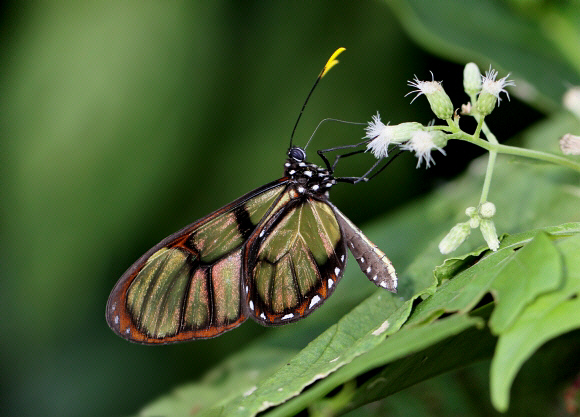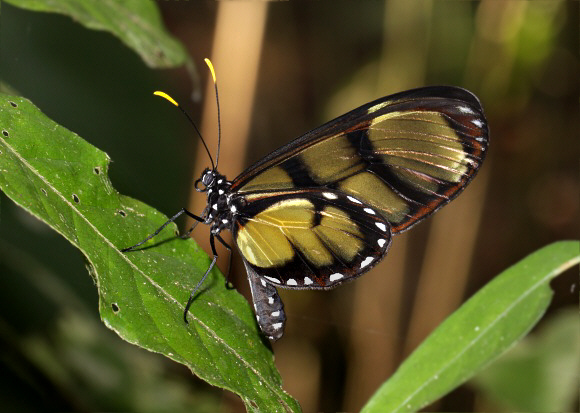
Introduction
The Ithomiini comprises of 376 known species, although it is likely that at least another 30 will be discovered in the near future. All are confined to the neotropical region. Ithomiines are unpalatable to birds, and are consequently mimicked in appearance by many other species. These include other unpalatable species ( Müllerian mimics ), not only from the Ithomiinae but also from several other butterfly families. There are also a large number of edible species ( Batesian mimics ) which have evolved similar patterns. Birds have the ability to memorise butterfly patterns and so learn to avoid eating noxious species, but are also fooled into ignoring similarly marked edible species.
Ithomiines are characterised by having small eyes, slender abdomens and long drooping antennae that lack distinct clubs. Males have a plume of long androconial scales or “hair pencils” on the costa of their hindwings. These are hidden from view when the butterflies are at rest, but are displayed when the wings are held open during courtship. Other Ithomiine characteristics include a very slow and deep wing beat, and a preference for inhabiting the darkest recesses of the forest understorey.
There are basically 2 types of Ithomiine. The first type are the black and orange-banded “tigers”, many of which are mimicked by other species due to their unpalatability to birds. The second type are the “glasswings”, recognised by their transparent or translucent wings, prominent veins, and orange wing margins. Many genera contain examples of both of these types, and in some cases an individual species may produce adults of both forms according to location.
Most novices find the Ithomiini very difficult to identify. Using only the patterns to identify species is very unreliable because there are so many similar species. Also many species produce a variety of different colour forms according to locality and season. The best approach therefore is to use the hindwing venation and other anatomical features to identify the genus, and to then look at the wing patterns to short-list the likely species.
The 7 species in the genus Dircenna all fall into the Glasswing category. They have several features in common – all are fairly large in size, with elongated forewings which have a very straight costa, and distinctively shaped discal cells. The hyaline areas of the wings in most species reflect a distinct greenish-yellow hue, although in 2 species ( jemina and olyras ) the wings are smoky orange.
Dircenna adina is distributed from Colombia to Bolivia. There are 11 known subspecies, including xanthophane which is restricted to Peru.
Habitats
This is a rainforest species found at altitudes between about 100-500m in the Amazonian lowlands and the foothills of the eastern Andes.
Lifecycle
I have no data specific to adina, and little is recorded about other members of the genus. Dircenna relata in Costa Rica lays its white eggs singly on Solanum ( Solanaceae ). Its larva is described by DeVries as being short and squat, pale green-white and covered with pale yellow warts.
Adult behaviour
The butterfly is widespread and fairly common but nearly always encountered singly. Both sexes nectar at Eupatorium flowers at dawn, and again in the late afternoon. They also reportedly nectar at Inga, Hamelia, and Impatiens.
Males sequester pyrrolizidine alkaloids from Heliotropium, Tournefourtia, Myosotis ( Boraginaceae ), Eupatorium, Neomiranda, and Senecio ( Asteraceae ). These chemicals confer toxic qualities to the butterflies which deter bird attacks. The chemicals are also used in the production of pheromones. Often the males of several Ithomiine species will gather together at communal leks, where they release these pheromones from hair-like androconial scales on the leading edge of their upperside hindwings. These attract more males, which in turn release further pheromones. After a few days the lek may include 50 or more adults comprised of as many as dozen different species. Passing females are attracted to the leks by the complex fragrances. Their presence stimulates the males to open their wings and release further pheromones that entice them into copulation. Females obtain sustenance from nectar, and also visit bird droppings which provide them with a source of nitrogen that assists with the development of their eggs.

